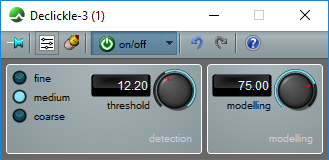Declickle

CEDAR invented real-time digital declicking and decrackling, demonstrating them to amazed audiences at the 89th AES Convention. However, these earliest digital declickers and decracklers suffered from a limitation; while they removed impulsive noises from the majority of material, they could damage sounds such as brass instruments, solo violins and singing, and all declickers based on the techniques revealed by CEDAR's original research still suffer from it.
Nowadays, Declickle 3 embodies new technology that offers better impulsive noise detection than any previous declicker. It not only detects the obvious clicks, but also high densities of low amplitude, short duration disturbances within the signal. It also incorporates a better interpolator than any previous declicker, resulting in superior performance across a wider range of material than ever before. Indeed, this performance is so good that, in almost all cases, it removes all traces of clicks and it's not possible to hear that the signal was damaged prior to restoration.